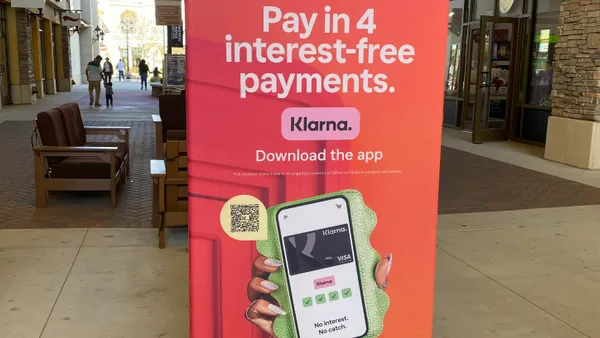Dive Brief:
- As payments innovations like buy now-pay later gain popularity, the share of monthly spending made with a primary credit card has dropped “significantly,” according to a new survey of U.S. credit cardholders from consumer research firm J.D. Power. The research firm defines a primary card as the credit card a consumer uses most often.
- Credit cardholders are now putting about 42% of their monthly spending on primary credit cards – down from 47% in 2021 and 2020, and from 50% in 2019, J.D. Power said in an Aug. 18 news release. Meanwhile, over the past five years, average monthly spending with cash grew 49% and debit card spending jumped 80%.
- Average spending with secondary credit cards has grown 35% since 2018, said John Cabell, director of banking and payments intelligence for J.D. Power. That suggests some consumers are spreading purchases across more credit cards than they have in the past, he said in an interview. Survey respondents were asked to report an estimate of the dollars they spend per month using various payment methods, and J.D. Power reports the average of all cardholder respondents, Cabell said.
Dive Insight:
Despite those shifts, customer satisfaction with credit cards rose five points to 810 (on a 1,000 point scale) over the past year, largely due to benefits and other services for cardholders as well as credit card terms, according to J.D. Power. Perceived levels of trust in card issuers also have increased six points, to 828, over last year. That’s likely a welcome shift to card issuers, after recent years’ decline in satisfaction.
The J.D. Power U.S. Credit Card Satisfaction Study gathered input from 27,819 credit card customers between August 2021 and June 2022.
Still, it’s noteworthy that a rise in satisfaction hasn’t been tied to a spending share increase, Cabell said. “Despite (card) issuers really working to win the hearts and minds of cardholders, there is still a lot of traction that other payment methods have,” he said.
BNPL, the trendy installment payments option, is among the new alternatives. In countries like Australia, BNPL “really took a bite out of the credit card share with younger consumers,” Cabell said. That could happen in the U.S. market, depending on how responsive card issuers are with their rewards programs and flexible payment plans. “If they end up being highly competitive on those fronts, it could certainly minimize the impact” of BNPL, he said.
Survey respondents told J.D. Power that reasonable fees and competitive interest rates were the main drivers for considering using BNPL. “The dynamic is difficult right now for credit cards compared with other types of payment methods,” Cabell said.
Although there’s been a recent spike in spending with credit cards due to travel and services-related purchases, the fact that the share of spending with primary and secondary cards isn’t much higher than it was five years ago indicates there’s “a little bit of reservation on the part of cardholders,” he said.
Cabell chalked that up to current economic uncertainty, which has tempered spending growth and usage of credit cards generally. About 57% of credit card customers are now considered financially unhealthy – four percentage points more than last year, J.D. Power said. The share of credit card customers carrying revolving debt also edged up, from 43% in 2021 to 49% this year.
With the portion of financially challenged cardholders expected to grow in the near future, options like BNPL might grow more appealing to consumers, since that consumer group is “much more sensitive and less satisfied” with credit card terms, Cabell noted.
Issuers also may have to work harder to ensure new customers are happy. “One of those surprising things that we saw is that new customers seem to be less satisfied than tenured customers with the card product,” he said. Customer satisfaction with credit card and banking apps has fallen, too, J.D. Power reported in June.
Among national issuers, card company American Express ranked highest in satisfaction, followed by its peer Discover Financial Services and Bank of America. The bank Goldman Sachs received the top spot among mid-size issuers, followed by rivals TD Bank in second and Fifth Third, PNC and Regions Bank tying for third.













